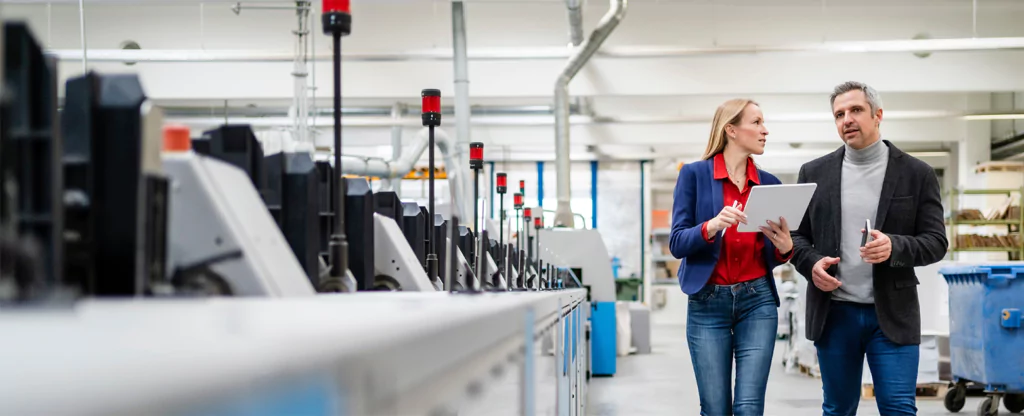Digital twins have become an essential element of industrial manufacturing. By offering real-time insights and simulations, they simplify various aspects of the production process, from product development to training and emissions management. See how a digital twin can be used in smart manufacturing.
Digital Twins in Industrial Manufacturing in 2024
The market for digital twins is estimated to be worth $73.5 billion by 2027.
Industrial manufacturing heavily integrates the physical and digital worlds to streamline operations and promote innovation. With recent advancements in computing power, analytics, the Internet of Things (IoT), and artificial intelligence, this technology has become increasingly crucial in manufacturing. In fact, up to 89% of all IoT platforms will include digital twins by 2025.
Let’s look at how digital twin technology is transforming industrial manufacturing. By significantly reducing the need for physical prototypes, it can shorten development time and improve product quality. We’ll explore this innovative technology and how it’s making a real difference in the sector.
The Digital Twin Concept Explained
Digital twins are digital replicas of physical assets, systems, or processes used in industrial manufacturing. They integrate IoT, AI, machine learning, and software analytics to create a living model that updates and changes as its physical counterpart does. Critical components of a digital twin include:
- Physical Asset: The actual machinery or system being replicated digitally.
- Virtual Model: A digital representation that mirrors the physical asset.
- Data Connection: A continuous data flow between the physical asset and its digital twin, enabling real-time updates and insights.
- Analytics & Intelligence: Tools and algorithms that analyze data to predict outcomes, optimize performance, and facilitate decision-making.
McKinsey reports that digital twins have significantly improved product development performance. This includes reducing the total development time by 20 to 50 percent, minimizing the number of preproduction prototypes required, and lowering quality issues by 25% when products enter production.
Additionally, products developed with digital twins have been reported to have 3 to 5 percent higher sales.
Recognizing the potential, the industry is already making significant progress in adopting digital twin technology, with 75% of organizations using it.
Benefits of Digital Twins in Manufacturing Operations
Digital twins are reshaping the manufacturing landscape, especially in product design and production phases. Here’s a closer look at their impact:
In product design, digital twins act as virtual prototypes, allowing designers to experiment with simulations before creating physical models. This process saves time and costs and enhances product quality by reducing the need for multiple iterations.
Digital twins optimize manufacturing processes during the production phase by mirroring the production line virtually. Sensors collect data to analyze performance, leading to insights on how to improve efficiency and reduce variances. The result? A smoother, more efficient production process.
One case study highlighted by McKinsey involves an industrial player using a digital twin to redesign production schedules, achieving cost savings of 5-7% per month. The digital twin also identified production bottlenecks, allowing for the optimization of product line sequencing to minimize downtime.
These solutions also enable predictive maintenance and minimize downtime. By predicting maintenance needs before issues become critical, digital twins help avoid breaks and extend the lifespan of machinery. This forward-thinking approach ensures operations run more smoothly and efficiently, with less interruption.
They are also crucial for improving the environmental impact of manufacturing processes by continually tracking carbon emissions throughout the supply chain. They help calculate the carbon footprint of product design and development, making the journey from design to delivery more transparent.
Moreover, digital twins improve operational efficiency across the board. Real-time monitoring and analysis offer a clear view of manufacturing processes, enabling quick adjustments that lead to better performance and reduced waste.

Implementation Challenges and Solutions
Although digital twin technology can be a game-changer for many businesses, several challenges must be overcome to take full advantage of this technology.
- Data Integration: It’s tough to get the right data in place. Issues with data ownership, access to real-time information, and varied quality standards make it hard to create accurate digital replicas of physical assets.
- Computing Power: Digital twins are data-hungry, requiring hefty computing resources and cloud storage to process information from numerous sensors in real time. Without the necessary infrastructure, this can be a steep hill to climb for businesses.
- Cybersecurity: The interconnected nature of digital twins opens up new security risks. Data encryption, access control, and regular security checks are vital to keeping threats at bay.
- Organizational Challenges: Integrating advanced technology into existing systems and workflows isn’t straightforward. It demands a shift in how teams work and a strong commitment from senior management to navigate the changes successfully.
- Specific Cybersecurity Risks: Did you know that creating digital twins doubles the attack surface for cyber threats? It’s crucial to include cybersecurity experts from the start and adopt a zero-trust approach to safeguard against unauthorized access and data breaches.
Guidelines for Effective Digital Twin Implementation
Sounds daunting? Here is how to ensure a successful implementation of virtual twins in the manufacturing environment:
- Start Small and Scale: Begin with a pilot project focusing on a specific asset or process. This allows you to manage risks, learn, and iterate before scaling to more complex systems.
- Evaluate and Adjust: Once you complete each phase, take a moment to evaluate the results against your objectives and make any necessary adjustments. This iterative process will help refine your approach and ensure it aligns with your goals.
- Take Care of Skill Development: It’s essential to train your workforce on digital twin technologies, emphasizing data analytics, system integration, and cybersecurity. This will help create a group of knowledgeable employees who can effectively interact with and utilize digital twins.
- Select the Right Partners: Collaborate with technology partners with proven expertise in digital twin technology, cloud computing, and cybersecurity. They can provide valuable insights, resources, and support for your implementation.
- Standardize Data: Establish clear data management standards and governance to ensure consistency and quality across different data sources.
- Use Cloud Solutions and Edge Computing: Invest in cloud services with scalable storage and processing for real-time data analysis from multiple sensors. Use edge computing for faster data processing closer to the source, reducing latency and bandwidth usage.
- Implement Security Measures: To mitigate risks, implement robust security measures, including data encryption, access control, and regular security audits.
- Identify and Protect: It’s vital to identify cybersecurity risks related to digital twins early on and take a proactive approach to safeguard both the digital and physical aspects of assets.
The Future of Digital Twins in Manufacturing
Digital twins in industrial manufacturing are increasingly linked to advancements like IoT, AI, VR, and AR, as well as to sustainability initiatives.
IoT advancements will allow for better data analysis, aiding supply chain optimization. VR/AR, cloud platforms, and blockchain will contribute to more effective management and secure data handling. Integrating IoT with AI and machine learning, on the other hand, will significantly enhance customization and supply chain optimization by enabling more accurate forecasting, personalized production, and streamlined logistics.
There is much to look forward to in the manufacturing industry 4.0, but you have to come prepared for the transformation.
Scalo stands out as a tech partner for manufacturing companies. With over 17 years of experience and a portfolio that spans various domains, Scalo offers tailor-made software solutions, agile development teams, and a deep commitment to adding technological value to businesses. Our expertise covers a broad technology stack, including cloud solutions, data services, and IoT integrations, making us well-equipped to support a wide variety of projects.
Contact us, and let’s talk about how you can optimize your manufacturing operations.





